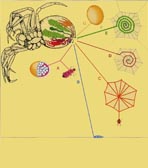|
The work of the Oxford Silk Group can be divided into six general areas all focusing on natural silks: Properties: The mechanical characteristics of a silk can be linked to physical and chemical traits and even to molecular structure-function relationships by combining a range of polymer testing and modeling techniques. Spinning: The extreme toughness of spider dragline silks depends on the controlled folding of all component proteins in the spinning duct. The structure of the protein feedstock in combination with the extrusion process produces the hierarchical structure of the multi-protein silk thread. The spider's complex spinning is a process that is largely devoted to the controlled extraction of water from an already rather concentrated protein-dope solution. Comparing spider and insect spinning is providing new insights into natural extrusion processes. Composites: The cocoons of silkworms and the webs of spiders give exciting insights the into natural requirements for material properties of both fibres and matrix and functional traits thereof. Evolution: Silks have evolved several times independently but most silks share a significant number of key traits. This convergence suggests that these traits are the prerequisite for a ‘good’ silk and in comparative studies we are trying to unravel the interrelationships between constraints and functionality. Sustainability: Life Cycle Analysis allows us to assign ecological costs and benefits to the various parameters involved in commercial silk production, and thus quantitatively assess sustainability parameters. Behaviour: Last but not least we are interested in the role played by behaviour in spinning, cocoon construction and web engineering.
|
|
